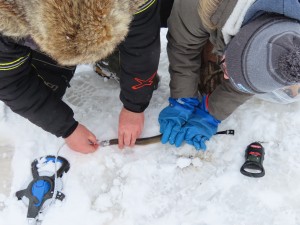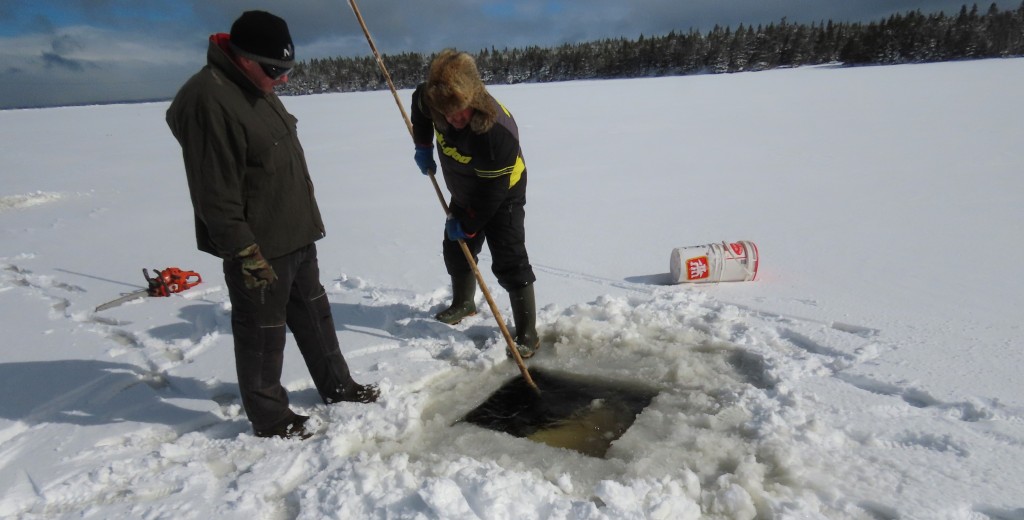Qalipu Environment and Natural Resources (QENR) has been working with traditional eel harvesters in Muddy Hole, NL for many years in order to document indigenous knowledge (IK) on eel harvesting methods.
Background
 The American eel (Anguilla rostrata) belongs to the family Anguillidae. It is also known as the Atlantic eel, Common eel, Silver eel, Yellow eel, Bronze eel and Easgann, among other names. In Mi’kmaq, it is known as kat, the Algonquins call it pimizi, Ojibwe call it bimizi and the Seneca call it goda:noh. It has the following characteristics: a slender, long body with scales, a single fin extends from its back around the tail to its belly, its mouth has thick lips and its lower jaw slightly longer than the upper jaw, it has several rows of small teeth on the jaws and roof of the mouth, its larvae are shaped like a willow leaf, juvenile (yellow eels) coloration varies from yellow to green or olive-brown on the belly and dark on the back, adults (silver eels) are grey with a white or cream-colored belly, adult females may reach up to 1 meter in length and males are smaller at less than 0.4 m.
The American eel (Anguilla rostrata) belongs to the family Anguillidae. It is also known as the Atlantic eel, Common eel, Silver eel, Yellow eel, Bronze eel and Easgann, among other names. In Mi’kmaq, it is known as kat, the Algonquins call it pimizi, Ojibwe call it bimizi and the Seneca call it goda:noh. It has the following characteristics: a slender, long body with scales, a single fin extends from its back around the tail to its belly, its mouth has thick lips and its lower jaw slightly longer than the upper jaw, it has several rows of small teeth on the jaws and roof of the mouth, its larvae are shaped like a willow leaf, juvenile (yellow eels) coloration varies from yellow to green or olive-brown on the belly and dark on the back, adults (silver eels) are grey with a white or cream-colored belly, adult females may reach up to 1 meter in length and males are smaller at less than 0.4 m.
The American Eel spawns in the Sargasso Sea and eggs hatch within roughly one week. The larvae drift passively, and are widely, dispersed by surface currents of the Gulf Stream system to western shores of the Atlantic Ocean. When larvae reach 55 to 65 mm in length, they metamorphose into ‘glass eels’, a post-larval stage characterized by a lack of pigment. As they approach coastal estuaries, they become pigmented and are known as ‘elvers’. This stage lasts 3 to 12 months, during which they may migrate up rivers or remain in brackish or salt waters, eventually becoming ‘yellow eels’. The yellow stage marks the growth phase where the skin thickens and sexual differentiation occurs. Between 8 and 23 years of growth are required for ‘yellow eels’ to become ‘silver eels’, at which time they are physically and physiologically adapted to migrate back to their spawning grounds. Adults mate randomly as one population (panmixia) and die after spawning. American Eel larvae are believed to feed primarily on detritus, while glass eels and elvers consume insect larvae. Yellow eels are night feeders and prey on a variety of organisms including small fishes, molluscs, insects and crustaceans. Silver eels do not feed during the spawning migration.
The survival of American eels is influenced by the following threats: habitat alteration, dams and turbines, fishery harvest, changes to ocean conditions related to climate change, contaminants and parasites. The decline of the American eel population may not only affect humans, but a variety of birds, fish and mammals as the American eel plays an important role in Canada’s aquatic biodiversity.
Status
This species was initially assessed in April 2006 by COSEWIC as ” Special Concern “. In May 2012, COSEWIC reassessed the status of the species and it was changed to ” Threatened “. Extended consultations are currently underway regarding the listing of the species on Schedule 1.
American Eel in Newfoundland

American eel (Anguilla rostrata) is an important food source for indigenous people in Newfoundland. There are currently a limited number of recreational licences remaining and new licences are no longer being distributed by the Government of Newfoundland. It is up to the current licence holders left participating to continue this traditional method of harvesting. Currently the recreational eel spearing season is open from November 1st to March 31st. QENR Natural Resource Technicians conduct two IK field days in Muddy Hole each year, collecting data to compare past and future harvests to observe changes in the abundance of eel in the area. Each eel caught has its life stage and colour documented then it is measured and weighed. From our observations, adult eels range from 28 to 70cm.
During the fall, both yellow and silver phase eels migrate downstream, with silver eels continuing their breeding migration to the Sargasso Sea. Again, these behaviors were utilized by traditional harvesters and still are utilized by commercial harvesters today. In the past, the Mi’kmaq people would use stone or wooden weirs to funnel migrating eel into traps, while modern harvesters tend to use a long funnel shaped trap known as a fyke net. During the summer, American eels move freely between and forage within their home rivers, estuaries, and lakes. However, most of their movements are limited to night, which is why traditional summer eel spearing was done by torchlight from boats. Many of these traditions are still practiced today, but, due to declining eel populations, fewer people are allowed to hunt for eels. That is why it is of utmost importance for the Mi’kmaq people and Qalipu Natural Resources to continue studying and protecting this traditional resource.
Cultural Facts
Did you know that the American eel is thought to be the Great Horned Serpent from Mi’kmaq and other First Nations legends? Also, the American eel skin was traditional used as a bandage for sprains and broken limbs and the skin could be made into thin strands to form hair strings. The oil from eel was used as a salve or ointment and parts of the American eel were provided as an offering to spirits to thank them for their help in surviving the winter.
References
COSEWIC, 2012. COSEWIC assessment and status report on the American Eel Anguilla rostrata in Canada. Committee on the Status of Endangered Wildlife in Canada. Ottawa. x + 71 pp. https://www.canada.ca/en/environment-climate-change/services/species-risk-public-registry/cosewic-assessments-status-reports/american-eel-2012.html
Resources
American Eel (Anguilla rostrata) – Species search – Species at risk registry (canada.ca)
American Eel | Traditional Animal Foods of Indigenous Peoples of Northern North America – Animals – Fish – Searun Fish
Eel of Fortune | Hakai Magazine
Mi’kmaq Fish and Wildlife Commission (MFWC): Mi’Kmaq Relationship with the Eel (stfx.ca)
